Since ancient times, garlic is especially appreciated by people. After all, it stimulates digestion, arouses appetite, and perfectly strengthens the immune system. He was considered an excellent antidote in case of poisoning. The culture was used for dangerous ailments as a prophylactic. Surprisingly, even opening the tomb of Tutankhamun, clay garlic was found in it. There is a mention of him on the Ancient Egyptian pyramids. And the great Pythagoras claimed that garlic is the king of spices. The amazing vegetable has been known to people for over 3000 years, but today it is also popular. Growing garlic is a simple procedure. But in order to get an excellent crop, you need to know some subtleties.
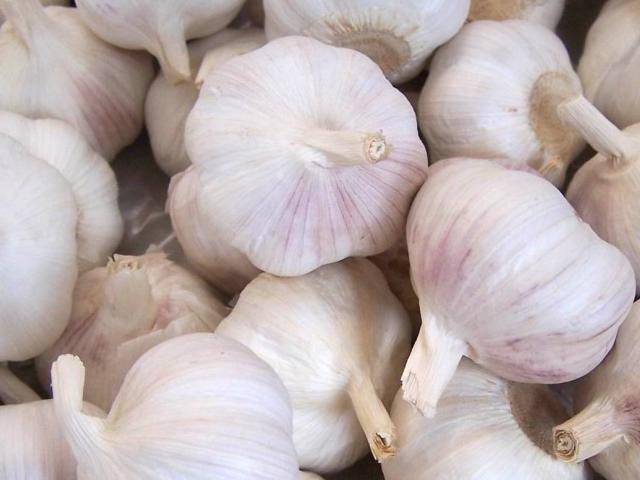
Growing Tips
Garlic is a fairly unpretentious plant. It will grow on any soil and with minimal care. But in order to get beautiful large heads, you need to plant it in time, choose the right place and take into account some other nuances. Therefore, consider what should be the cultivation of garlic.
Experts give the following recommendations:
- Choose a garlic bed in a well-lit place. You should not plant a vegetable in a lowland. The accumulation of water will lead to decay of the slices.
- It is recommended to use beds that were previously occupied by legumes, cabbage, radishes, cucumbers. And it is completely undesirable to take those areas on which potatoes grew. Do not use sites that have recently been used under growing onions garlic. These are highly not recommended predecessors, which will lead to a decrease in yield.
- You should not plant this culture several times in a row on the same area. Use the previous places is allowed only after 4 years.
- Before planting, be sure to apply complex fertilizer to the ground. You can use rotted manure or compost.
- For planting, choose large bulbs. The teeth must be carefully removed and never cleaned. Damaged tubers should not be used.
- It is recommended to dig a bed 1 week before the planned planting. Garlic should not be planted in freshly excavated soil. Otherwise, as a result of rainfall, the bulbs will be deeply planted.
Such recommendations will allow you to achieve a wonderful harvest. In addition, thanks to them, growing garlic will not cause you much trouble.
Varieties of garlic
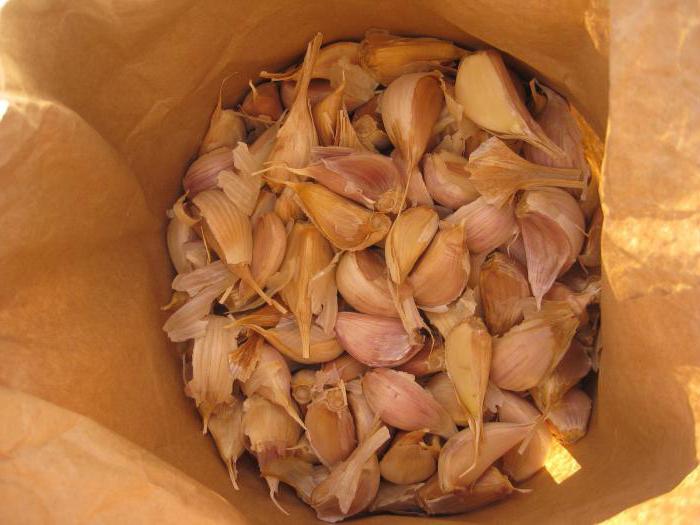
Breeders have developed many varieties. You need to familiarize yourself with them if you plan to grow garlic.
Cultivars intended for open ground are divided into 3 groups:
- winter non-shooting;
- winter shooters;
- spring non-shooting.
Let's look at them in more detail.
Winter varieties ripen early. They are distinguished by a plentiful harvest, have large teeth and heads. However, such garlic is not suitable for long-term storage. It is used for cooking or as a seasoning for pickling and canning.
The following types are winter varieties:
- Boguslavsky;
- Komsomolets;
- Jubilee Gribovsky;
- Petrovsky;
- Losevsky;
- Gribovsky 60;
- Gulliver;
- Flight;
- Anniversary 07;
- Prometheus;
- Sofievsky;
- Sail;
- Lyubasha
- Leader;
- Promin
- Saksky.
Spring varieties are much better preserved. However, they require special storage conditions.
The following types of spring garlic are common:
- Ukrainian white;
- Gafuri;
- Degtyarsky;
- Ershovsky;
- Elenovsky.
Preparing for planting winter varieties
It is necessary to take care of both the seed and fertile soil. Only in this case will your harvest of garlic bring a rich harvest.Such varieties are planted in open ground 35–45 days before the onset of frost. This is the end of September - the first days of October.
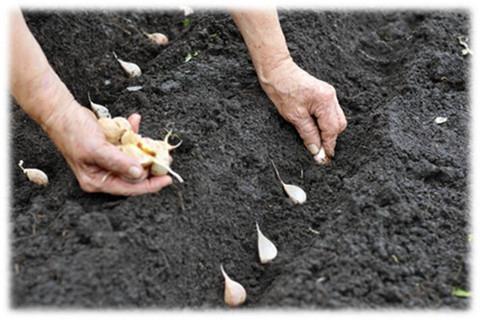
But before planting the cloves, it is necessary to carefully prepare the seed:
- Choose large bulbs. Separate them immediately before planting.
- If the head of garlic contains only 2-3 cloves, then this bulb is unsuitable for growing, since such an amount indicates the degeneration of the culture.
- Every 3-4 years, planting material should be updated.
- If at least one diseased tooth is found, it is necessary to process the seed 12 hours before the planting process. To do this, garlic is soaked in copper sulfate (1%) or in a weakly concentrated solution of potassium permanganate.
- It is recommended to warm seed before planting at a temperature of about 40–42 degrees for 8–10 hours. But the room should be well ventilated.
The cultivation of winter garlic involves the preliminary preparation of the soil:
- The culture has a weak root system. It is in the topsoil. Therefore, fertile neutral soils are chosen for planting.
- Garlic, as noted above, is not planted in the lowlands. However, the elevation is not suitable for him, since the wind will blow snow from the surface, and this will lead to freezing of the culture.
- Sandy soil is best suited for culture. Soil preparation must begin 7-10 days before planting. Start by digging a plot (25 cm deep). After removing all weeds, fertilize the soil. Humus is brought into the ground (only not fresh manure) - 5-6 kg, superphosphate - 30 g, potassium salt - 20 g per 1 m². And in 1-2 days the soil is fertilized with ammonium nitrate, using a ratio of 10-12 g per 1 m². Water the soil well. Cover the area with plastic wrap.
Landing rules
The technology for growing garlic is not too complicated.
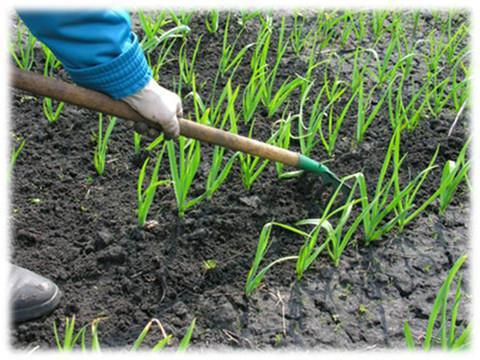
But here you should heed the advice of specialists:
Planting crops begin at a time when the temperature regime of the soil is 12-15 ° C. It is very important to choose the right time so that the culture has time to form a normal root system. Only in this case can we hope for a rich harvest.
- Do not be afraid of emergence of shoots. Well-rooted garlic is not afraid of winter. And if the root is not sufficiently developed, then the winter hardiness of the culture is significantly reduced.
- Carefully level the area immediately before landing. Between rows with garlic, provide a distance of 20-25 cm. And observe the interval between the cloves. It should be at least 10-12 cm. Garlic cloves can be planted in grooves. Remember, they should not be pressed into the ground. Otherwise, root development will be severely delayed.
- Planting depth depends entirely on the type of soil and the size of the cloves. Large planting material is planted to a depth of about 8–9 cm. Medium cloves are planted at 6–7 cm. Do not forget that a small planting can lead to freezing of the crop.
- The garlic bed must be mulched; use peat, sawdust or humus. To retain snow on the site, it is recommended to spread brushwood.
- As soon as the spring thaw begins, the top layer is removed. This will protect the culture from being warmed up. Carry out such a process with a rake extremely carefully. After all, shoots may already appear.
Crop Care Rules
Garlic responds well to organic, mineral fertilizers. Cultivation and care of the crop involves top dressing in early spring. During this period, the land is still frozen. Use phosphoric, potash fertilizers.
To get a rich harvest, you need 3 top dressings:
- At an early time, superphosphate (90-100 g), ammonium nitrate (60 g), potassium sulfate (50-60 g) per 10 m² are added to the soil.
- After 25-30 days, the culture needs a second top dressing. For her, the same fertilizers are used, and in the same amount.
- Garlic is fertilized a third time, when the heads grow significantly and become similar in size to walnuts.
Your plants need watering, weeding. It is recommended that once every 14 days the soil be loosened to a depth of about 3 cm. The culture does not tolerate excessive moisture. But this does not mean that it should not be watered. This procedure should be repeated constantly. Garlic is especially in need of moisture in the early stages of vegetation, when the germination of the stem and the formation of cloves are observed. Water the crop abundantly. The soil should be saturated with 30 centimeters. It is necessary to moisten the soil every 7-10 days.

The first watering should coincide with top dressing. Days 25-30 before harvest, soil moisture must be stopped.
Features of the preparation of spring garlic
Now we will consider subtleties of landing and leaving for this type of culture. Growing spring garlic should begin with a thorough preparation of the site and selection of planting material. Let us dwell on these points in more detail.
In early spring, the cultivation of garlic begins. The plant is planted in open ground in the first days of sowing work (no later than the initial decade of April).
The following tips will help to properly prepare the seed:
- Spring varieties are distinguished by many cloves. The sowing properties of the inner lobules are much worse than the outer ones. Therefore, it is recommended not to take medium segments for planting.
- Garlic should be preserved during the winter at a temperature of 20 ° C. In March, it is necessary to disassemble the bulbs into teeth. Then this material is soaked in water for 2-3 hours. Wet teeth are transferred to a cool place. They must be laid out on the surface in a small layer and covered with a cloth on top. Such an event will allow garlic to sprout. By the time of planting in the soil, the cloves should have roots of about 2-5 cm.
Preparing the soil for these types of garlic should be the same as for winter crops. Humus should be added to the land set aside for planting. In addition, it is recommended to add wood ash in the ratio of 3 cups per 1 m².
We plant spring garlic
Cultivation needs to observe the following points:
- Garlic is planted in moist soil.
- Teeth should be deepened by 4-6 cm. This allows you to correctly place the planting material and prevents it from bulging to the surface.
- The distance between the lobules in the same row is 6-8 cm for large cloves, and 4-6 cm for medium-sized lobules.
- After planting, the soil is mulched. The best fertilizer for the crop is horse manure, well rotted.
- Despite the fact that these plant varieties do not belong to frost-resistant varieties, they are able to grow well at low plus temperatures.
- Culture is very photophilous.
- They feed the plant in early spring, when good shoots appear. An excellent fertilizer is a mixture of a weak infusion of mullein (1:50) with ash. The second feeding should occur at the end of June. Spring garlic does not need to be fertilized a third time.
- In the first 2 months after emergence, the crop needs hydration. If there is a drought or heat, it is necessary to deeply soak the soil.

Garlic Harvest
When should you harvest? It is recommended to start cleaning at the end of August - the first decade of September.
You can determine the readiness of the crop as follows:
- Non-shredding garlic ceased to form new sprouts. Feathers died. Bulbs are fully formed and are characterized by a characteristic color.
- Shooting garlic will announce the readiness for harvesting cracked inflorescences. At the same time, the onion bulbs will begin to crumble.
- Spring garlic is harvested when the lower leaves are well dried.
It is important not to be late for cleaning. Otherwise, growing garlic will not provide you with the desired crop. After all, culture will resume its development. This will lead to the disintegration of the heads into lobules. And such garlic for storage is completely unsuitable.
Before storage, the crop should be dried. The best onions are immediately selected for planting. Spring garlic is recommended to braid in braids.In this form, it is able to persist perfectly for 18 months.
How to grow garlic from bulbs?
Getting excellent yields for several years in a row, you will come across the fact that the culture begins to lose the characteristics of the variety, the heads become smaller. This signals the degeneration of garlic. In this case, updating of planting material is required.
Experienced gardeners, noticing the degeneration of the culture, undertake the cultivation of garlic from bulbs. This is one of the main secrets of getting an excellent harvest.
Such cultivation occurs as follows:
- Air bulbs will appear on the failed shooters. They are called bulbs. Collect them.
- In the first days of October they begin to be planted in the ground. The soil should first be fertilized. For planting, we make grooves at a distance of 10 cm from each other. The depth of the row should be 4 cm. Pour the furrow profusely and drop bulbs into it.
- Around July-August, you will notice that the tops of your crop turn yellow. This is the time to harvest the garlic. Carefully scoop it up one tooth at a time. Dry the planting material thoroughly.
- Planting such teeth in the ground is recommended in October. Next year you will get an excellent full crop.
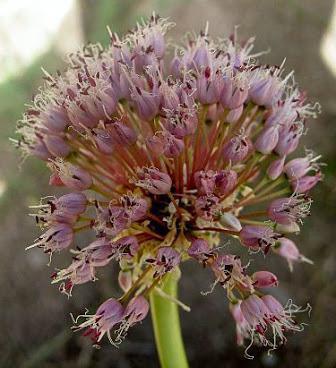
Opinion of people
What do gardeners who have been cultivating garlic for more than a year say? The reviews of experts indicate that, following the right technology, you can get an excellent harvest.
To do this, you need to remember the timing of planting, choose the right site, carefully monitor the planting material and do not forget about the rules of care. Periodically, as noted above, every 3-4 years, garlic must be updated. To do this, grow a culture of bulbs.
If you consider all the recommendations, you will be pleased with a rich harvest.








